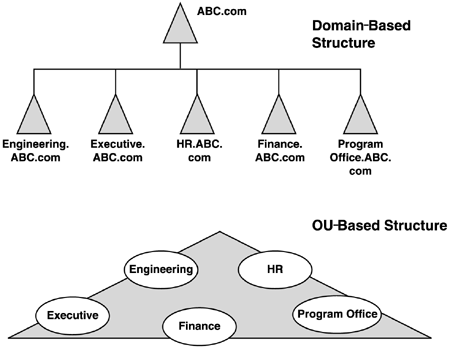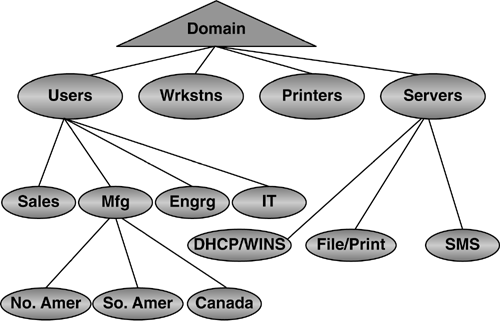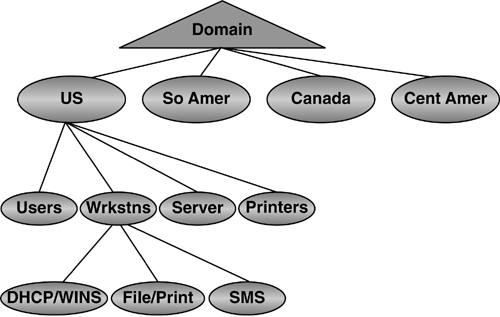2. Forest Structure
Just as there are business and technical reasons for
creating a single- or multiple-domain forest, there are also reasons to
create a single- or multiple-forest AD infrastructure enterprise. Some
say AD domains are security boundaries just like they were in Windows
NT, and in a very limited sense they are; for example, for defining
password policies. However, it is well known today that the true
security boundary is at the forest level. In the beginning of Windows
2000 deployments, there were few multiforest deployments. However, a
number of multiforest environments exist today and there are good
reasons to employ such a structure. It was noted in the discussion on
domain design that you should start with a single domain and prove you
need more. This rule is even more important in regard to designing the
forests.
Although there are many issues to consider in the
single versus multiple domain debate, there are only a few when deciding
whether you should use a multiple forest environment. It basically
comes down to two issues: political and security. Microsoft defined the
security issue with the following statement (from “Using the
Organization Forest Domain Model” Web site article):
“Domain owners have authority over the entire domain,
as well as access to all other domains in the forest. For this reason,
domain owners must be trusted individuals selected by the forest
owner...Keep in mind that if a forest owner delegates domain-level
service management to a domain owner, then other groups might choose not
to join that forest if they do not trust that domain owner. All domain
owners must be aware that if any of these conditions change in the
future, it might become necessary to migrate the organizational domains
into a multiple forest deployment.”
This statement describes the importance of trust in
those who are domain Administrators and the important security rights
they have in the forest. It also points out that if others in the
organization do not trust a domain Administrator, it may be cause for
creating a separate forest. One government official I talked to several
years ago was configuring a test environment to prove he could control
security of data in a single domain. Because the implementation of
Windows 2000 involved several government departments, if he lost his
case, it could mean the creation of about 20 forests.
In addition to security reasons, there can be
political, business, or even legal reasons to deploy a multiple-forest
enterprise. In analyzing these reasons, perhaps it's easiest to outline
the negative impact of multiple forests. The strongest arguments against
a multiple forest deployment are administration and implementation of
Exchange.
A good example of resolving the multiple forest issue
is demonstrated in an AD design project I was involved in. This was a
fairly small company that included an autonomous business unit. One
business unit, we'll call it ABC, had a legal requirement to be
separated from the rest of the company.
It seemed after the assessment, that the rest of the
company could adopt a single domain in a forest. However, an engineering
division had operated Windows NT domains independently of the IT
department. The IT department managed the Windows NT environment for the
rest of the company. The research division was lobbying for a
multiple-forest environment to retain this autonomy, making an
enterprise of three forests, all running on the same physical network.
The IT Administrators, however, wanted only one additional forest in
addition to the ABC forest. This discussion became very political, and
my partner and I were asked to make a presentation to describe the pros
and cons of a multiple-forest deployment. The reasons to have multiple
forests include
Maintain absolute security autonomy:
The forest is a definite security boundary. However, a trust can be
built to allow one or more groups or users access to resources in
another forest. This really boils down to the use of the enterprise
Admin account, which cannot be restricted from any domain in the forest,
although there are certain rights it doesn't have. If no account can
have access across certain domains, then multiple forests are required.
Business autonomy:
Business requirements might be such that data and security must be
separated as though they were separate companies. One company had seven
forests—one for each business unit. A holding company might employ a
multiple forest structure for this reason.
Administrative autonomy:
As Microsoft noted in the article we quoted previously, Administrators
that are not trusted by other domains can lead to multiple forests. Note
that you should work this out rather than make multiple forests. This
would have to be a very serious issue to justify the added cost of
another forest.
Business partner relationship:
Perhaps you have a business partner that you want to share data with.
Establishing a separate forest and controlling access via trusts would
ensure security for each company.
External Web farms in a Demilitarized Zone (DMZ):
Many companies deploy Web farms that exist in a DMZ for security. In
addition, it's difficult to replicate through a firewall, thus making a
separate forest desirable.
When analyzing the reasons to deploy a
multiple-forest structure, weigh the negative aspects associated with
multiple forests, as noted in Table 2.
Table 2. Comparison of Single and Multiple Forest Features
| Feature | Single Forest | Multiple Forest |
|---|
| Enterprise Admins group | No way to restrict members of this group in any domain in the forest. | Enterprise Admin rights restricted to the forest their accounts exist in, unless a trust is built and specific rights assigned. |
| Replication topology | Single topology—adding more components for additional domains or sites is much less demanding than an entire new forest. | A
separate topology is required for each forest. Forests cannot share
common sites, site links, and so on. This can impact the network
bandwidth. |
| Kerberos cross forest trust | Not applicable. | Allows
a single trust to be established at the forest level and honors the
transitive trusts of each forest. Rights can be restricted or wide open.
This is animportant feature. |
| Hardware costs | Only applicable if additional domains are created. | Requires
considerably more hardware to establish new domains, multiple DCs in
each domain, and so on (same as creating multiple domains in a single
forest). |
| Administration | Each Admin needs only one account and appropriate rights added. | A
cross forest trust (Windows Server 2003 only) allows accounts to have
rights in multiple domains. Windows 2000 allows this, but requires a
separate trust between each pair of domains, increasing administration
of the trusts. |
| Trust management | All trusts are created and maintained without Administrator intervention. | Requires
manual creation and maintenance of external trusts. Windows Server 2003
permits a single root- level trust. Windows 2000 requires separate NT
LAN Manager (NTLM) trusts between each pair of domains. |
| Time services | Can be synchronized automatically between all domains and maintain security for authentication time stamp. | Must
be synchronized manually between domains (can use same external time
source). Security for authentication time stamp only within each forest
itself. |
After presenting these issues to technical and
managerial participants in the meeting, they kept pressing me to boil it
down further. After reviewing their business and political environment,
I decided it came down to two issues: the role of the Enterprise Admin
and Exchange. Members of the enterprise Admins group cannot be locked
out from any domain. This was a political concern because the research
department Admins didn't trust the IT folks and vice-versa. They didn't
want the other Admins in their data—a basic issue of trust as
Microsoft's statement previously cited notes. Exchange was an issue
because the company, including the ABC business unit, wanted to appear
as a single organization. All employees should have a “[email protected]”
e-mail address. Because Exchange uses the GC as the Global Address List
(GAL), you can't have an organization spanning forests without
synchronizing AD objects between the forests. It is possible to
accomplish this by giving users in multiple forests a single e-mail
address by the use of Simple Mail Transfer Protocol (SMTP) forwarding,
but synching up contacts, calendar, and free/busy information is a huge
challenge.
Gathering all the interested parties together, I
presented these two issues as those that needed to be decided to resolve
the question of whether the research department should have its own
forest or simply an OU in the company's root domain. In regard to the
enterprise Admin issue, it came to an issue of trust that should be
controlled by company policy. Anyone who had enterprise Admin privilege
should be required to abide by company policies that detail proper
conduct and use of that authority. If they don't abide by that policy
and if you can't control your employees, that's a management problem—not
Windows. I then had an Exchange expert—Don Livengood,explain what was involved in getting Exchange to work
across three forests—the administrative overhead and difficulty in
keeping calendaring and free/busy data in sync. Recognizing e-mail
functions as a mission-critical application, one Administrator said, “I
think people wouldn't mind a power outage if they could get to their
e-mail.” This discussion ended in a decision to adopt a single forest,
single domain for these organizations. The point is that making the
right decision took identifying the reasons not to adopt a multiple
forest enterprise, getting all the parties together to discuss it, and
urging them to do what is best for the company.
Although the company's reason for wanting multiple
forests was to ensure division of administrative duties, this can be a
reason for other enterprises not to go to multiple forests. This
requires some fairly complex security group organization if you have
Administrators who must have domain Admin or enterprise Admin rights in
more than one forest.
tip
Windows Server 2003 makes multiforest enterprises
much easier to manage with the addition of Kerberos-based, cross forest
trusts. These trusts allow Administrators in one forest to grant very
granular access to resources in another forest.
3. OU Structure
The OU, of course, is an excellent alternative to
multiple domains. Microsoft recommends using OUs to create directory
partition structures for changeable entities. For instance, rather than
making domains for Engineering, HR, Executive, Finance, and Program
offices, OUs are a better solution because these names can change. Figure 9
compares a domain-based and an OU-based implementation. Although
Windows Server 2003 has Domain Rename capability, it isn't trivial and
there are still a lot of unresolved issues concerning application
support. Building OUs allows not only flexibility of rename and
restructure, but also requires no additional hardware for new DCs. Also,
moving objects between OUs is much easier than between domains.
Movement of users across domains requires tools such as Microsoft's
Active Directory Migration Tool (ADMT), LDIFDE, or movetree.exe.
Movement between OUs can be done in the AD Users and Computers GUI
(Graphical User Interface).

tip
In Windows Server 2003, you can select multiple objects (such as users) and drag and drop them onto another OU.
In designing an OU structure, although there are no
real design rules, some best practices have been developed from
experienced AD designers. The structure really is determined by whether
your focus is on Group Policy or administration. Most likely, you will
need to consider both in your own design.
Group Policy-Based OUs
One common structure (and similar to that used by HP)
that you might consider using is to divide up the first-level OU
structure into users and computers. This is a Group Policy-based
approach. Because policy is partitioned into user and computer settings,
and you can actually limit a Group Policy Object (GPO) to apply only
computer or user settings, OUs divided in this way make sense. Figure 10
shows an example of how a three-tier OU structure based on policy might
be structured. Note that the first level has OUs titled Servers,
Workstations, Printers, and Users. The second level further divides
users into Sales, Manufacturing, Engineering, and IT staff. The second
level under the Servers OU includes File/Print, Systems Management
Services (SMS), and DHCP/WINS (Windows Internet Name Service).
Similarly, you could subdivide the printers and workstations OUs, or
leave them as single-level OUs. The Manufacturing OU contains a
third-level OU structure that divides the Manufacturing users into
geographies of North and South America and Canada. This demonstrates the
flexibility of the OU structure. Some OUs need be only one level deep,
some can be two, and others three or more.

Administration-Based OUs
An administration-based OU's model is primarily based
on the requirements of a company for the delegation of administrative
rights. The structure would look something like that shown in Figure 11.
This is almost the reverse of the Group Policy-based structure. Here,
you have the geography-based OUs at the top of the structure, the
computer- and user-based OUs at the second level, and the subdivisions
of those OUs (such as that shown for the Servers OU) on the third level.
Obviously this would work if your Administrators were organized by
geography. If organized by business unit, you could replace the
geography OUs with business unit names.

In working with the Qtest Windows 2000 testing
environment at HP (originally created at Compaq), I decided to create an
OU structure for the QAmericas domain and struggled through several
designs. During this exercise, I decided that the most important thing
in this environment was administration. Administrators were scattered
throughout North and South America. I needed an OU structure that was
conducive to permitting Administrators to get to all resources in their
geography. Imagine the nightmare if I used the Group Policy-based
structure. My Administrators' accounts would reside in the
geographies—the third tier in the structure. But there would potentially
be more geography-based OUs at that level requiring some interesting
delegation so that each South American Admin could manage South American
resources. However, if I apply the administration-based structure shown
in Figure 5.11,
all the South American resources are under the South America OU. I can
put the South American Admin accounts in that OU, or perhaps put them in
a child OU, and delegate rights appropri ately. It's really amazing as
you look at different structures and review your business needs, how the
solution eventually presents itself to you.
OU Depth
The depth of the OU tree is really governed only by
the Group Policy structure that affects logon performance and what you
can live with. Microsoft published data for Windows 2000 that specified
that each GPO applied to a user-generated 58K, and each GPO applied to a
computer-generated 72K of traffic. On startup and logon, each policy is
copied from the DC to the workstation. Thus, the more policies that
apply to the user, the longer it takes to log on. Note that a user is
penalized only for the GPOs that apply to the user—not the total GPOs
defined in the domain. This is actually predictable.
A good example of an OU design exercise was a large,
global enterprise based in Atlanta that had already determined that its
OU structure was to be six levels deep when I was asked to review the
design. The interesting thing was that all of the objects—users,
computers, printers, and so on—were in the sixth-level OU. The other OU
levels contained only groups and were designed to look like the business
organization.
Concerned about this, I convinced my coworkers that
we should review the structure. We locked ourselves in a conference room
for about three hours one day and drew all possible OU
structures—basically iterations of the Group Policy- and
administration-based structures discussed in this section previously. As
we drew the structures on the whiteboard, we tried to fit the company's
administration model into them. Finally it was evident that the only
way to meet the business needs of the administration model the company
wanted was to implement the six-layer OU model. I was satisfied with
that because we challenged the model and proved it was the best
solution.
Note that if we had taken the rule of thumb of not
going more than three levels deep, we would not have arrived at the best
solution. In addition, this six-level structure didn't impact the logon
performance more than if it had been a single-level structure because
the number of GPOs would be the same. If you want to reduce the logon
time, you reduce the GPOs or groups, not the OUs.
Default and Special-Purpose OUs
By default, one OU is created during AD installation:
the DC's OU. This OU, by default, houses all DCs and contains a Default
Domain Controller (DDC) GPO. Although you can move DCs to any OU you
want to, I don't recommend it. DC security policy is really in its own
world, even by Microsoft's standards. Moving DCs out of the DDC's OU and
changing the DDC's policy is adding a degree of uncertainty to the
environment. If you run into security issues in the future, you should
first ask whether it's because the DCs are not in the DDC OU. There
might be valid reasons to do this, but make sure it's critical enough to
pay the potential price.
note
The users and computers containers under the domain
container are just that—containers—not OUs. In Windows 2003, you can
convert these containers into OUs so that Group Policy can apply to
them.
Special-purpose OUs are used
to house objects temporarily during an installation or as a staging area
for migration. They also can be used to troubleshoot problems such as
group membership or Group Policy application. For instance, they can be
used to synchronize objects in the AD for legacy e-mail environments
such as Exchange 5.5 and GroupWise. Temporary OUs can be used to house
the synchronized mailbox user contacts.